Japanese resources
> Msgraph
Queensland Curriculum and Assessment Authority. Sourcebook modules provide teachers with a range of learning and teaching ideas.
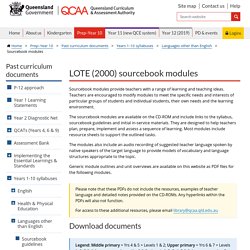
Teachers are encouraged to modify modules to meet the specific needs and interests of particular groups of students and individual students, their own needs and the learning environment. The sourcebook modules are available on the CD-ROM and include links to the syllabus, sourcebook guidelines and initial in-service materials. They are designed to help teachers plan, prepare, implement and assess a sequence of learning. Most modules include resource sheets to support the outlined tasks. The modules also include an audio recording of suggested teacher language spoken by native speakers of the target language to provide models of vocabulary and language structures appropriate to the topic.
Generic module outlines and unit overviews are available on this website as PDF files for the following modules. For access to these additional resources, please email library@qcaa.qld.edu.au. Japan Foundation, Sydney – Bringing Japan To You. ゆるキャラ®グランプリエントリーキャラクター|ゆるキャラグランプリ オフィシャルウェブサイト. Resources for Primary. The Japan Foundation, London - Language Centre. JSOW is based on The National Curriculum in England, 2013 and consists of tasks of A1 level, provided by JF Standard for Japanese-Language Education, which was developed by the Japan Foundation in 2010, based on the concept Common European Framework of Reference for Languages (CEFR).
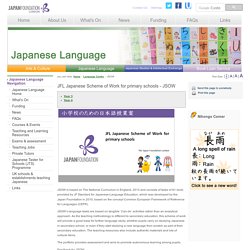
JSOW’s language tasks are based on tangible ‘Can-do’ activities rather than an analytical approach. As the teaching methodology is different to secondary education, this scheme of work will provide a good base for further language study, whether pupils carry on studying Japanese in secondary school, or even if they start studying a new language from scratch as part of their secondary education. The teaching resources also include authentic materials and lots of cultural items. The portfolio provides assessment and aims to promote autonomous learning among pupils. Feedback for JSOW: "I just wanted to let you know that I taught my first Japanese lesson yesterday to Year 5 children.
Year 3. Onomatopedia - オノマトペディア. How to Type Japanese. Language Learning Space. ST ITA'S JAPANESE - Hiragana Karate Club. Last year (2017) we started St Ita's Hiragana Karate Club.
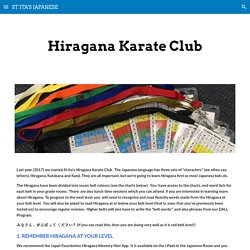
The Japanese language has three sets of "characters" (we often say letters), Hiragana, Katakana and Kanji. They are all important, but we're going to learn Hiragana first as most Japanese kids do. The Hiragana have been divided into seven belt colours (see the charts below). You have access to the charts, and word lists for each belt in your grade rooms.
Incursions/Excursions
Worksheets etc. Shuwa. Pictures/ClipArt. Videos. History. Kanji. Levelled readers. 'Minna no Kyozai' website (members-only website for Japanese-language teachers.)
Outschool: Small Online Classes for K-12 Learners. Support, ideas and resources for teachers of languages. Japanese. The Japan Foundation, London - Language Centre - Teaching Resources. Wherever possible we have tried to credit the creators of all resources featured here.
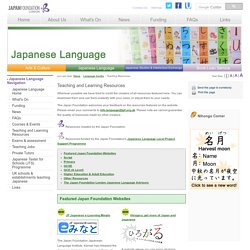
You can download them and use them instantly with your class, or adjust them to your needs. The Japan Foundation welcomes your feedback on the resources featured on the website. Please email your comments to info.language@jpf.org.uk. Please note we cannot guarantee the quality of resources made by other creators.
Exciting Japanese Language Textbooks & Tools for Teachers & Parents.
Easy Japanese - Download Lessons. [50音・漢字の活動集] by 【虹色日本語教室】スパイス効いたゲーム・教材・活動集. 実は、はじめ五十音表を現地人の先生たちに配ろうとしたときに、ネットで無料提供されている既存の五十音表を探したのです。
![[50音・漢字の活動集] by 【虹色日本語教室】スパイス効いたゲーム・教材・活動集](http://cdn.pearltrees.com/s/pic/th/50-by-182705225)
できれば、手間を省きたいですから(笑) しかし、いろいろ、調べてわかったのです。
ネットで調べて出てくる無料の五十音表は、日本の小学生向けのものばかり。
だから「て」なら「てんとうむし」なんて、子どもなら親近感があるものの、外国人にとっては身近とは限らないし、初級でそもそも勉強する必要はないし。 また、ひらがなとカタカナがひとつの表になっているものも多いです。
JLTAV. MRLT resources! – Google Drive. Schools interested in exchange opportunities. The following schools in Australia/New Zealand and Japan have expressed interest in establishing sister school relations.
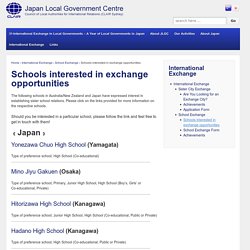
Please click on the links provided for more information on the respective schools. Should you be interested in a particular school, please follow the link and feel free to get in touch with them! 《 Japan 》 Yonezawa Chuo High School (Yamagata) Type of preference school; High School (Co-educational) ………………………………………………………………………………………………………….. Mino Jiyu Gakuen (Osaka) Type of preference school; Primary, Junior High School, High School (Boy’s, Girls’ or Co-educational, Private) …………………………………………………………………………………………………………..
Valiant Japanese Language School - Minato-ku, Tokyo, Japan. Make Learning Fun: The Best Japanese Learning Games. Learn Japanese language - free online games.
Japanese games for language learning on Digital Dialects All Japanese games are free to use, do not require registration, and are suitable for kids and students of all ages.
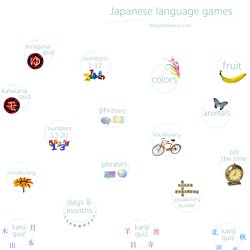
Games for learning Japanese language in HTML5 (work on current browsers) include Japanese phrases, Japanese numbers, animals quiz, basic vocabulary quiz, days and months in Japanese and a colors quiz. We also make Japanese games for moblies and tablets.
Languages Online - Japanese. JLPT N5. Tofugu — A Japanese Culture & Language Blog.
Family
Erin's Challenge! I can speak Japanese.
The Japan Foundation, London - Language Centre - Teaching Resources. Wherever possible we have tried to credit the creators of all resources featured here.
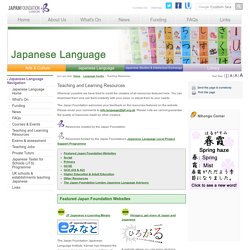
You can download them and use them instantly with your class, or adjust them to your needs. The Japan Foundation welcomes your feedback on the resources featured on the website. Please email your comments to info.language@jpf.org.uk. Please note we cannot guarantee the quality of resources made by other creators.
Japanese Teaching Ideas.





![[50音・漢字の活動集] by 【虹色日本語教室】スパイス効いたゲーム・教材・活動集](http://cdn.pearltrees.com/s/pic/th/50-by-182705225)


